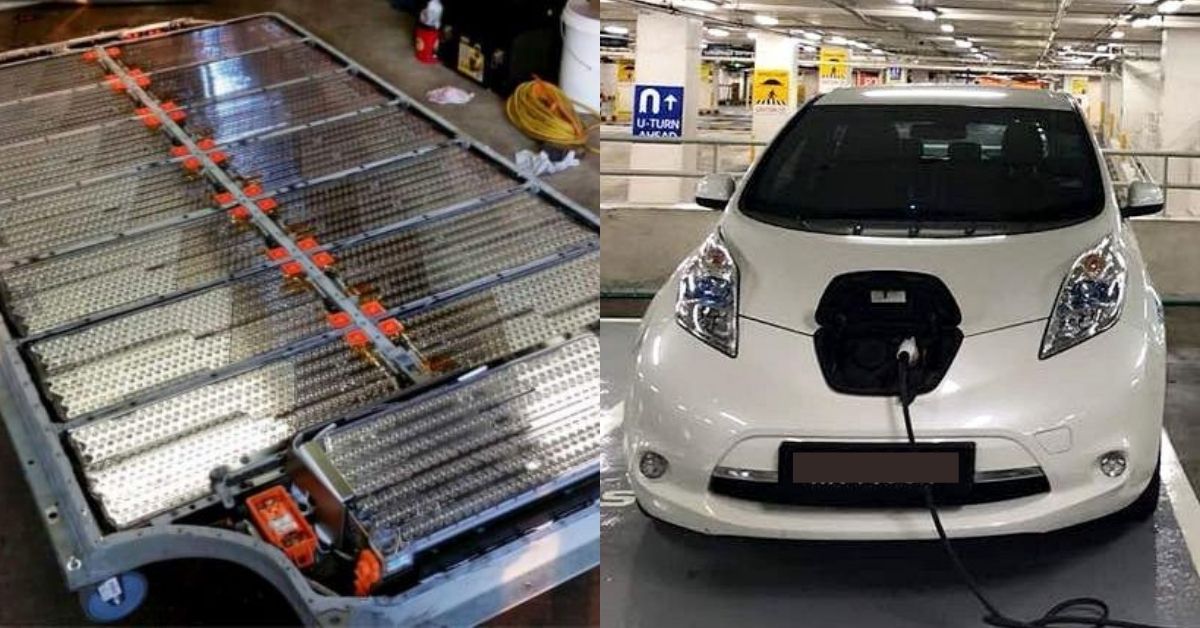Scientists are warning of a climate emergency where reducing greenhouse gas emissions, improving air quality in urban centres, and meeting the needs of consumers are top priorities. In light of this, we’re seeing the rapid growth of electric vehicles (EVs) adoption.
But just like the rechargeable batteries in your phone, the batteries in EVs won’t last forever. With global EV sales forecasted to reach 12 million units in 2025 and over 20 million by 2030, the question is, how will we deal with dead EV batteries?
The Life Of An EV’s Battery
EVs use several hundred large lithium-ion batteries (LIBs)—think your phone’s battery—that are bundled together to function as one. Conventional petroleum cars on the other hand, use lead–acid batteries.
Both are rechargeable, but have different properties in terms of their lifespan and efficiency. LIBs can accept a faster rate of current, meaning faster charging speeds compared to lead-acid batteries. This is critical for time-sensitive situations where vehicles have a high utilisation and fewer break intervals.
LIBs also weigh less, which increases an EV’s range and performance. Compared to lead-acid batteries, LIBs are 1/3 of the weight, 3 times more powerful, and have 3 times the lifespan, which is an estimated 15-20 years.
After a few thousand charging cycles, the performance of a typical LIB pack can no longer power the vehicle and must be exchanged for a new one. But that supposedly spent battery doesn’t just get thrown away.
Or at least, it shouldn’t, because it’s not exactly “dead”, per se.
It’s Not The End Yet
Though the LIB pack has lost effectiveness during its life cycle, it can still hold up to 80% of its power. While it’s not suitable for continued road use, it can be adapted for other purposes in less demanding uses.
For technology to be sustainable, it’s no longer an option to simply throw away products that are no longer fit for their original purpose. EV batteries are expensive and loaded with limited raw materials like lithium and cobalt that are harmful to dispose of and pose risks of exploding when piled up in landfills under heat.
Before they’re disposed of, these batteries should first be repurposed to be reused for a different function, such as charging stations or stationary energy storage to power factories, residential buildings, hospitals, etc.

In fact, Toyota in 2018 came up with a scheme that hooks up old EV batteries to solar panels to power convenience stores in Japan.
Meanwhile, Korea’s trade ministry partnered with LG Chem to produce portable battery packs, AKA power banks, using discarded EV batteries. These are instances of how used LIBs can be given a second life. It’s also how governments can implement responsible solutions while accommodating the growth of their country’s EV adoption rates.
Tesla has its own programme where it claims 60% of LIB components are recycled once they’ve reached their end of life. To add, 10% of these batteries can be reused to build a new battery case for an EV.
The battery’s modules are the only material from Tesla’s LIBs that goes into the landfill. But before they’re dumped, the parts are frozen, shredded, and crushed into harmless lint that won’t contaminate the soil. Copper-cobalt gets sold to recycling centers, and slurry blocks can be used for painting appliances.
Now, despite these examples, the problem is that very little recycling of EV batteries goes on today, with many still ending up in landfills leaching toxic chemicals that pollute our soil and rivers. In Australia, only 2–3% of LIBs are collected and sent overseas for recycling. In the EU and US, the rates are less than 5%.
Most of the batteries that do get recycled undergo a process called “smelting” where high-temperature melting and extraction take place. And for EVs, the dismantling process requires trained mechanics to do so by hand with specialised tools.
This consequently leads to high labour costs in developed countries, where revenue from the extracted materials may not be economically worth it. Thus, automated disassembly techniques with robotics can become a possible solution.
As Malaysia is still falling behind in the global EV race, we have yet to come up with solutions for recycling such commodities. But the question now is, will we be prepared to do so when the time comes?
Perhaps taking a look at how we’re handling it on the small scale in the form of phone batteries might give us an idea.
We’re Merely A Collection Site
Malaysia’s e-waste recycling rate looks a little more optimistic at 25%, according to the Department of Environment (DOE) in 2020. However, the actual number for recycled LIBs itself is inconclusive.

ERTH’s founder, Mohamed Tarek El-Fatatry told Vulcan Post that Malaysia unfortunately has no such facility to break down e-waste at the moment.
So in 2019, the e-waste recycling centre donated used LIBs from phones to Nanyang Technological University (NTU) in Singapore. They were used as test materials for the institution’s new device that could shred batteries and extract cobalt and lithium.
“They were able to recover up to 90% of the materials from expired batteries and repurpose them into new ones,” he shared.
Mohamed Tarek added that some local companies are collecting LIBs for export to Korea. But during the pandemic, this activity was halted. “Nowadays, we donate our old LIBs to hobbyists who try to make solar storage systems from old batteries,” he said.
While Malaysia may merely be an e-waste collector right now, it presents opportunities for local startups to crop up in the battery life cycle management space. Furthermore, EV manufacturers themselves could look at ways to recycle their own batteries, following Tesla’s example.
And as authorities are still finalising policies and the infrastructure to accommodate EVs, it would be worth it to also lay down proper plans on how to dispose of the batteries 15 years down the road.
- You can read more articles we’ve written about EVs here.









